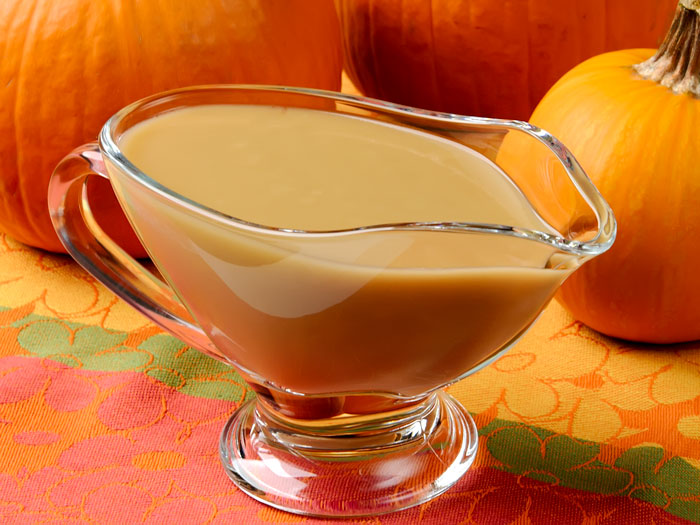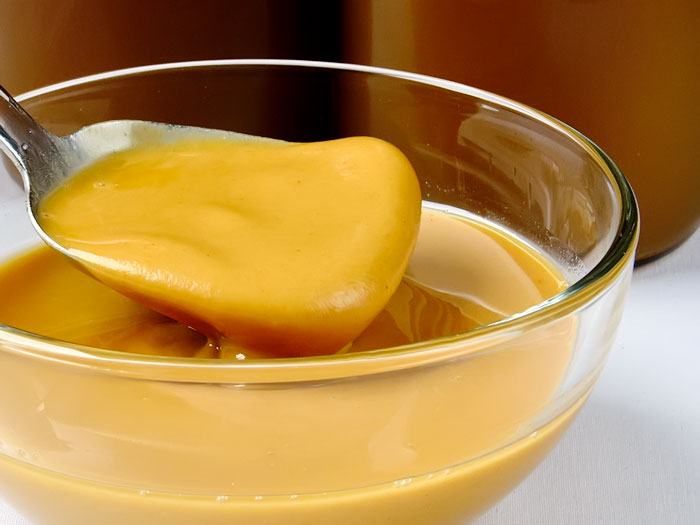Thanksgiving isn’t Thanksgiving without turkey gravy. And not just any turkey gravy will do. It starts with a roux.
I’ve been making roux since I began to cook our weekday meals in the second grade. In my family, a light golden roux was the base for pan gravy, which was the mandated accompaniment to mashed potatoes. Many years later, I learned about a darker version, which is the base for French brown sauces and traditional Creole dishes, such as Gumbo.
In my estimation, the ultimate Thanksgiving gravy depends on a properly made roux. It’s not difficult to produce and lends the gravy a roasted flavor dimension that can’t be obtained with a simple flour and water or cornstarch and water slurry.
Once you’ve tasted Thanksgiving gravy made this way, you will never want any other.
It’s All About the Roux
Because it takes about 30 minutes of constant attention to make a medium colored roux, I like to make a triple or quadruple batch and store it in the refrigerator. It keeps a very long time.
Most traditional recipes for roux call for a 1 to 1 ratio between the fat and flour. I’ve discovered that 1 to 1½ works just as well and has the benefit of decreasing the amount of fat needed to thicken the gravy, soup, or gumbo.
NOTE The flavor of deeply colored roux may be an acquired taste. If you are not sure whether you like this flavor, stop cooking the roux at a light camel color.
NOTE Even though unsalted butter is listed as one of the fats you can use to make a roux, clarified butter, oil, or poultry fat are somewhat easier to use, because the developing roux is a bit looser and doesn’t burn as easily. You can also take the roux to a deeper color with these fats, as they burn at a higher temperature than unsalted butter. For a light or medium colored roux however, unsalted butter works just fine.
½ cup unsalted butter, clarified butter, vegetable oil, or poultry fat (some folks even use bacon drippings or lard)
¾ cup unbleached, all-purpose flour
- In a large, heavy-bottomed sauté pan or stove-top casserole, over medium-high heat, heat the butter, oil, or fat and whisk in the flour.
- Continue whisking as the roux goes from a light golden color, to a light caramel color, and then finally to a deep caramel color. If you see black specks in the developing roux, the flour is burned. Throw the roux out and begin again.
- Remove from the heat and continue whisking for another 4 minutes or so, until the roux stops darkening.
- Let cool, and then skim off any fat that has collected on top of the roux.
- Refrigerate until needed.
Makes about ¾ cup roux; enough for 1½ quarts of gravy.
Thanksgiving 24-Hour Gravy (Roux-Based Gravy)
This is the Thanksgiving 24-Hour Gravy I debuted many years ago for a family Thanksgiving dinner. It has become a sacrosanct tradition. Thanksgiving is not Thanksgiving without this gravy.
I call it the 24-hour gravy, because it takes the better part of a day to produce the stock upon which the gravy depends. If you have the stock prepared in advance, however, this gravy takes only ½ hour to make.
You need only a medium colored roux here, so the rich flavor of your turkey stock retains the starring role in the gravy.
½ cup medium colored roux (recipe above)
1 quart Brown Poultry Stock, warm
½ cup drippings from roast turkey, strained and fat removed
finely ground sea salt
freshly ground black pepper
- In a large saucepan, heat the roux.
- Slowly whisk in the Brown Poultry Stock and strained turkey drippings.
- Bring to a simmer, whisking constantly.
- Cover partially, and simmer slowly for 10-15 minutes, until gravy reduces slightly, and tastes full flavored and silky smooth.
- Season to taste with salt and pepper.
- Remove from the heat and keep warm until needed.
- You can also cool and refrigerate for up to a week or freeze for up to three months. Reheat when ready to serve.
Makes about 1 quart gravy.
Cookin’ with Gas (inspiration from around the web)
- Cooking Louisiana: Making a Roux
- Cooking Louisiana: Progressive Roux Colors
- Michael Ruhlman: How to Make Thanksgiving Gravy
- Michael Ruhlman: Turkey Gravy for Thanksgiving
- Sarah’s Cucina Bella: Fool Proof Herbed Turkey Gravy
- Steamy Kitchen: Making Roux
- The Jittery Goat: Recipe for Roux
- Wikopedia: Roux
Copyright 2012 Susan S. Bradley. All rights reserved.




Made a double batch of medium color roux for turkey gravy a few days ahead. When I removed it from the refrigerator it was as hard as a brick. I tried various ways of softening it and was finally successful in making the best gravy I’ve ever made.
Question is: is the roux suppose to solidify when made ahead of time and refrigerated?
Hi there C. G. Yes, because roux is made with butter, it solidifies when chilled. It should liquify when heated. If it remains rather solid, even after heating, it’s because the proportion of flour is greater than the proportion of butter. No worries though; just proceed with the gravy. All will be well.
Thanks for getting back to me re: chicken gravy…I make a pretty good chicken stock; but yours looks
better…when I think of gravy, it usually involves adding some milk or cream…any ideas? Thanks again,
Kate
Kate, yes, use the basic formula and substitute cream or half-and-half for about 1/4 of the stock.
What a treat to have some of this with your turkey! Good idea that you had of making this in a large batch too!
Lorraine, thank you!
Oh, Susan, I could just hug you! I made the roux and it came out just exactly as you said it would. I let it get to a medium brown and it was perfectly smooth. The nutty aroma of the browned butter and flour mixture was so delectable, I could have almost stopped right there and made butterscotch pudding out of it! But I didn’t. I forged on and let it cool then skimmed the very little excess of oil from the top, let it cool awhile, then went ahead and made gravy out of the stock. Success! It is the most velvety gravy. It thickened the stock perfectly to the consistancy of a light-to-medium bechemel sauce and the flavor is excellent thanks to your stock instructions. The stock was rich with loads of flavor and just like jello in consistancy. I got 2 quarts of stock from my 3 wings and 3 legs after letting them roast to a deep golden brown. My husband tasted it and was ready to just drink it as is. I can’t wait to add the turkey dripping to it tomorrow. I make pretty good gravy my old way, it just takes so much juggling at the ladt minute. This is better and easier because I can take my time getting the roux perfect and know that the drippings will add just the finishing touch This is going to be the easiet TG dinner I’ve ever put on the table… Thank you so much!
Susan, you’ve made my day! So glad everything worked for you. I would have a revolt here if I tried to pass off regular gravy for 24-hour gravy. And as you discovered, it’s so much easier to make it mostly ahead. Have a wonderful day tomorrow!
So glad everything worked for you. I would have a revolt here if I tried to pass off regular gravy for 24-hour gravy. And as you discovered, it’s so much easier to make it mostly ahead. Have a wonderful day tomorrow!
Susan, oh yes, definitely! That’s what I’m doing as well. Great question, thanks for adding clarity for folks.
Susan, can you make this gravy with just the turkey stock, reserving some extra roux, then chill it overnight, and add the turkey drippings and reserved roux to it when you reheat it? The gravy making seems to be the thing that holds up dinner most of the time, I’d really like to get a jump on it today.
I don’t understand this. Why hold back anything to add later? I thought the whole amount cold just be reheated? No?
Cathy, just reviewed the post, and I’m not seeing what you are describing. The gravy can be made completely ahead (I did that last night). The only last minute task (and not absolutely essential) is to add the turkey drippings after the bird is roasted. That adds an extra dimension od supreme deliciousness and caramel color. Hope this helps. Happy Thanksgiving!
It’s fun to read your comment with good-looking photos.
I’m still challenging the way to make cookies.
Thanks!